
Kanheri Caves
Located deep within the Sanjay Gandhi National Park in Mumbai, Kanheri Caves are a group of 109 Buddhist rock-cut monuments dating from the 1st – 10th century A.D.
Prior to land reclamation during the 19th and 20th centuries, the area around the caves was known as Salsette Island and was probably quite heavily populated in ancient times. Similar (but much smaller) cave complexes exist at nearby sites such as Jogeshwari, Mahakali and Mandapeshwar, all of which are well worth exploring if time permits.
This suggests that Salsette Island was an ideal location for the settlement of a large Buddhist community. With ancient trade routes nearby it would have enabled the monks to come into contact with the merchant community, who in turn would provide continuous patronage in the form of gifts and endowments, which is evident from the various inscriptions that have been found here.

Kanheri Caves (1896), from the Gazetteer of the Bombay Presidency by James M. Campbell
The 109 caves are located on three hills, with a stream flowing between the northern and southern hill which collects water at the eastern end. It’s clear that the monks here did all they could to utilize every drop of rain water, with a complex series of small water channels cut to enable almost every cave to have it’s own water cistern.
As you can see from the map above, the site is vast and nothing can quite prepare you for that. There is no definitive route around the complex, and at times you can get a little disorientated as to where you actually are within the overall site. Each cave has it’s own number, sometimes labelled at the front of the cave but not always. The cave numbering system is primarily down to the order in which they were originally recorded, so you’ll find for example Cave 42 right next to Cave 72.
What follows is a pictorial account of the main highlights at Kanheri, along with a brief description of what can be seen. This is numerical order, as it seemed the only logical way to go about it.
Cave 1

Facing west, Cave 1 is a Buddhist monastery (vihara) with two gigantic pillars very similar to those that can be seen in Cave 1 at Elephanta. Attempts to make this a two storeyed cave appear to have been abandoned, probably due to a defect being discovered in the rock.
Cave 2

Also facing west, Cave 2 consists of three stupas each set in their own chambers and a vihara. Mortise holes on the façade of the cave suggest that there was once a large wooden roof at the front. Having a shrine with more than one stupa is relatively unusual, so it’s interesting as to why this was deemed necessary at Cave 2.
The most elaborately carved chamber houses Stupa 3, with multiple panels depicting Buddha in a standing or teaching attitude, often the same image repeated many times over.
Cave 2 has five inscriptions in total, one records a gift of a refectory by Nakanaka from Nashik, another a gift of a water cistern by Svamidatta, a goldsmith from Kalyana.
Cave 3 – Chaitya Cave

Cave 3 is the largest and most visited cave at the site, with a substantial courtyard the entrance to which is flanked by two guardians (dvarpalas). One of the highlights of Kanheri Caves has to be the carvings found here on the side walls of the vestibule.
Here are two gigantic 7m high statues of Buddha, the photos don’t really portray the sense of scale, but they’re hugely impressive. On the left leg of the Buddha to your left as you enter the cave there’s some graffiti – “A Butfer, K.B., J.B., J.S., 78” which (perhaps unfortunately) records a visit by Ann Butfer, K Bates, John Butfer and John Shaw in 1678.
Flanking the central entrance to the hall are four donor couples.
Similar depictions of donors can often be found at the entrance to Buddhist Chaitya halls, another great example (and possibly of slightly higher quality) can be seen at Karla Caves located between Mumbai and Pune.
The hall, measuring 26m long, 12m wide, and 15m high is spectacular – remember that all of this was carved out of solid rock !! I have visited so many of these Buddhist Chaitya halls now, including Karla, Bhimashankar, Bhutalinga, Kondana, Amba-Ambika, Lenyadri, Tulja Lena, Bedse, Bhaja, Ellora, Ajanta and Mahakali – and yet they never fail to stop me in my tracks.
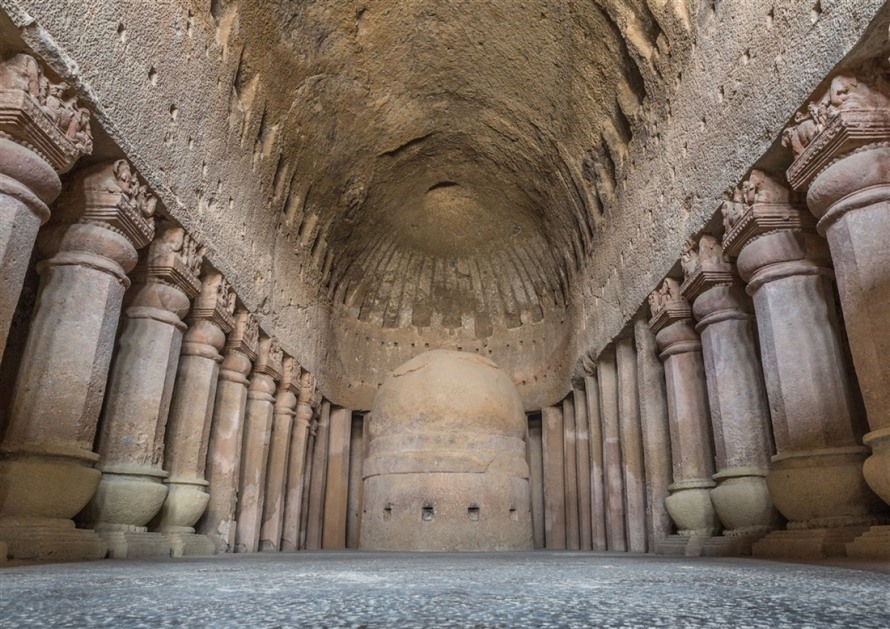
The hall consists of a nave, two aisles, and 34 pillars. Not all of the pillars are finished, which perhaps suggests that this excavation occurred in more than one phase.
The finished pillars have carvings of elephants, nagas and humans worshiping stupas, as well as humans riding elephants and horses with lions.
The vaulted ceiling has grooves for wooden rafters that have long since gone, and at the far end of the hall is a 5m high stupa.
Thanks to a foundation inscription we can accurately date this cave. It states that the cave was founded by two merchant brothers, Gajasena and Gajamitra, during the reign of Sri Yajna Satakarni, the Satavahana king.
This pinpoints a date to around 180 A.D. which is later than the almost identical Chaitya hall at Karla Caves, which is considered to be of a higher quality in terms of style and art. Scholars have suggested that the reason for this may be that the donors were not able to sufficiently fund the completion of the cave, or that perhaps they died before the work was finished.
On leaving the cave, the left courtyard pillar (right pillar as you approach the cave) has an unassuming and yet quite significant carving at the base.

Here Buddha is shown standing wearing a robe and with a halo behind his head. This small carving is believed by many to be the earliest representation of Buddha among all the caves of western India.
Cave 4
Just north of Cave 3, a flight of steps leads up to a small circular cell housing a stupa.
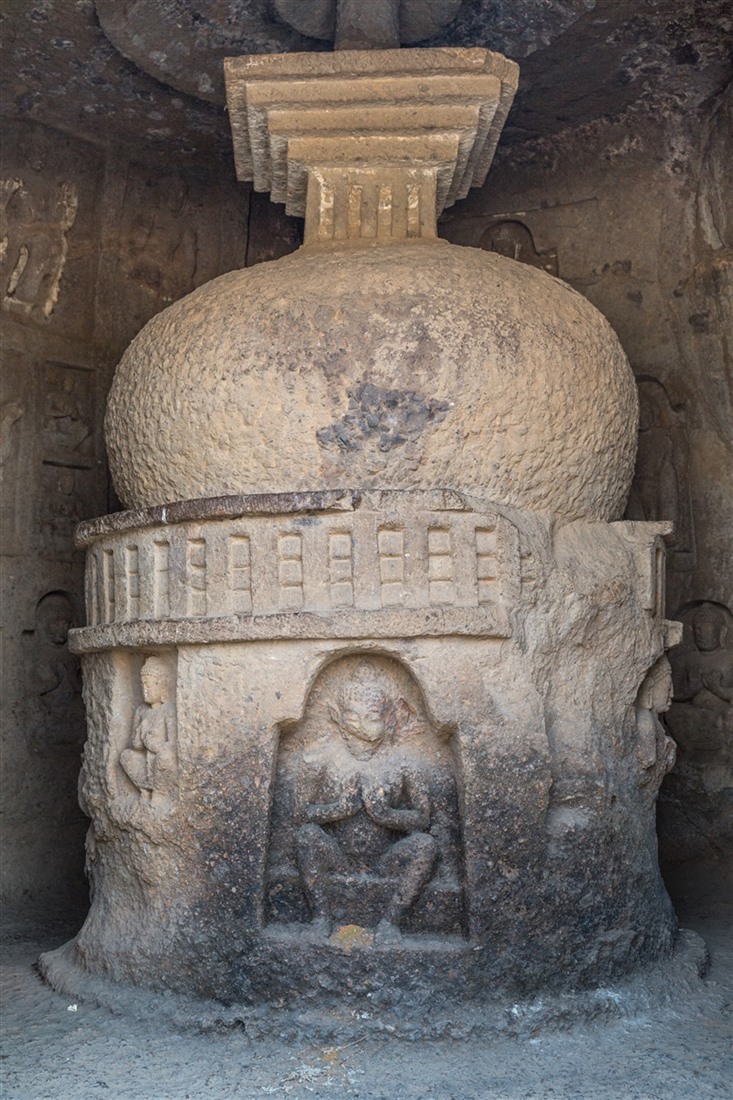
It is thought that may be the earliest of all the excavations at Kanheri, an inscription on the stupa mentions that it was a gift from Sivapalita, the wife of the treasurer Dharma.
Cave 11 – Darbar Cave

With a veranda supported by eight octagonal columns, this is the largest monastery (vihara) at Kanheri.
The Hall contains 12 cells in total, 9 on the back wall and 3 on the left wall. The interior space is impressively large and could have held as many as 500 people, but with only two stone benches its designed capacity is probably close to 100 people.
Cave 12
Caves 16 & 17
Cave 19
Cave 21
Although a simple cave, it does have an inscription from the time of the Satavahana king Gautamiputra Satakarni
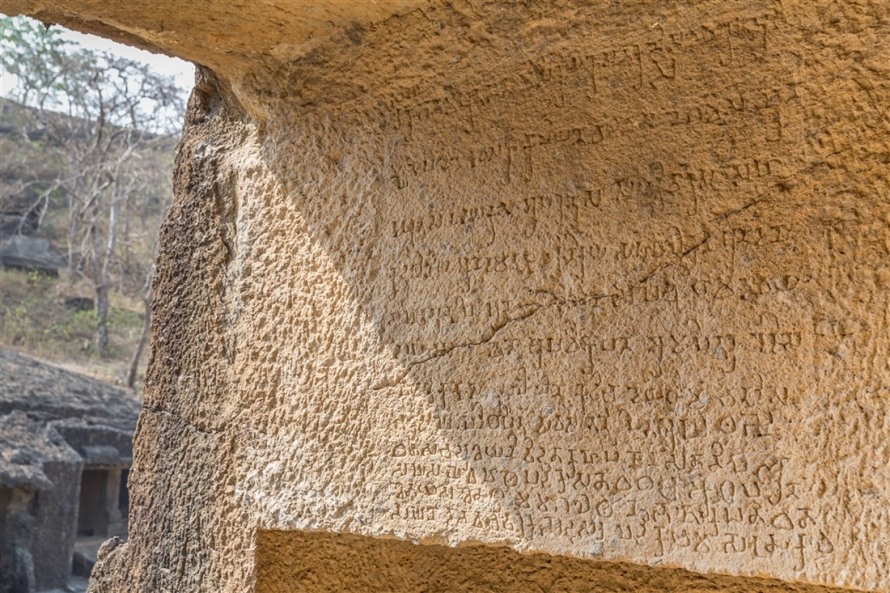
It mentions that the cave was excavated by a merchant and his family, who all came from Kalyan.
Cave 23
Cave 25

Cave 26

Caves 27 & 28
Cave 32
Although at first glance this cave might appear to be unassuming, it is an important cave as it introduces many new architectural features. Above the courtyard (at the very top of the photo below) there appear to be mortise holes, possibly provision for a wooden canopy that would have projected forward.

The entrance wall has two perforated lattice windows, with the hall housing benches. An inscription on the left chamber of the entrance records that this cave, its cisterns and benches were a gift from Dharma, a merchant from Kalyan.

Dharma also made some permanent endowments to support clothes and shoes for the monks that resided here. This inscription is dated to the 4th century A.D.
Cave 34

From the outside, this is another cave that doesn’t appear to offer much, but that all changes once you enter the interior.
Here there are some wonderfully atmospheric carvings of Buddha, with just enough light being cast to capture them. On top of that, this cave contains something that probably 90% of visitors completely miss. It’s another instance where you have to always remember to look up !
Cave 34 is the only cave at Kanheri where remains of paintings can still be found on the ceiling. This is of Buddha in the Bhumisparsha Mudra (earth touching) gesture.

The painting is unfinished, and seems to have originally intended to depict more than one figure. This together with the carvings inside Cave 34 has to make it another of the highlights of Kanheri.
Cave 36
This cave is very similar to Cave 4, with a steep flight of steps taking you to a small cell containing a stupa.

Notice how the ceiling of the cell has the faintest hint of paintings, although now mostly worn and eroded away.
Cave 41
The amount of light penetrating the interior of this cave was almost non-existent which made photography almost impossible. A lesson for anyone visiting these caves…bring a torch !
This cave is another that is actually quite significant. It contains the only representation in stone of the eleven-headed Avalokiteshvara in India, the most famous Buddhist god. The depiction of Avalokiteshvara in wood evolved in Nepal and Tibet, I’ve seen quite a few examples in the Ladakh region of India, most notably at Lamayuru Gompa.
Cave 67

This cave is known as Chitrashala (picture gallery), and it’s obvious to see why.
This huge cell is covered with carvings depicting scenes from the life of Buddha and Jataka tales. Thanks to the bench surrounding the cell, I was able to get some half decent in focus long exposures in this cave, so apologies for the volume of images :-).
Caves 84 – 87 : The Kanheri Necropolis
Due to the density of brick stupas in front of these caves, they are considered to be the necropolis (or burial ground) of the Kanheri complex.

In total there are around 60 brick stupas here, mostly ranging in size from 1.2m to 1.8m in diameter, except for a single larger stupa. Excavations of these stupas hasn’t yielded any relics, it’s now believed they were probably housed in the cupolas which have all since disappeared.
44 small stone inscriptions have been found around these caves mentioning various monks who have reached different levels on their path in Buddhism. This possibly suggests that Kanheri was an important seat of learning (or university) for Buddhism during the 5th and 6th centuries.
Cave 89

Although a small cave, the interior is carved with many images, most of them hard to capture due to the lack of available light.

In the above image Buddha is shown seated with Padmapani and Bodhisattva. Above Buddha’s head is a mango tree, with some wonderfully carved images of a monkey sucking the mangoes, and a bird having a good peck at them 🙂
I suspect that some time in the future I will need to return to Kanheri armed with a decent torch so I can better capture some of the carvings in these darker caves.
Cave 90
Although another small cave by Kanheri standards, the interior is extensively carved with images.
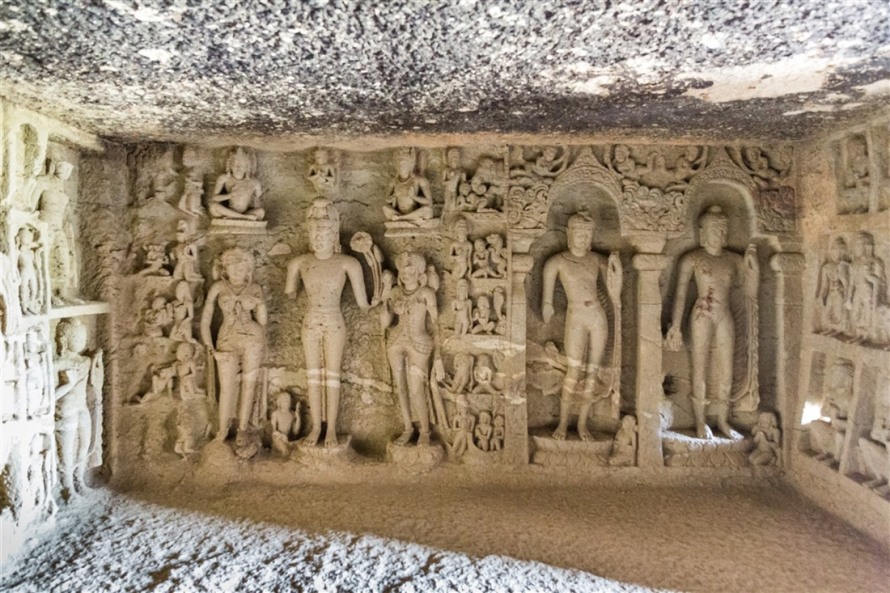

Graffiti in the form of Japanese script, dated to after the 12th century A.D. exists on the veranda at Cave 90.

Cave 93
Yet another cave filled with amazing carvings. Unfortunately my time at Kanheri was now running short, so just a few shots of this one…
I was surprised just how much there is to see at Kanheri Caves, and perhaps trying to see these 109 caves in addition to Jogeshwari, Mandapeshwar, and Mahakali was a little on the optimistic side. As a result, my time at Kanheri was limited to just three hours, when in reality I should have set aside the whole day.
My tips for visiting are as follows :
- It’s best to avoid weekends, simply to reduce the number of fellow explorers.
- Plan to arrive early. On my visit the caves opened at 9am, but do check opening times.
- Be prepared for a lot of walking, wear very comfortable shoes !
- Ensure you have plenty of snacks and water, the site is quite spread out.
- Bring a decent torch.
- Bring plenty of memory cards and spare camera batteries, you might well be needing them :-).
You’re welcome to ‘Like’ or add a comment if you enjoyed this blog post. If you’d like to be notified of any new content, why not sign up by clicking the ‘Follow’ button.
If you’re interested in using any of my photography or articles please get in touch. I’m also available for any freelance work worldwide, my duffel bag is always packed ready to go…
KevinStandage1@gmail.com
Categories: India, Kanheri Caves, Maharashtra, Mumbai















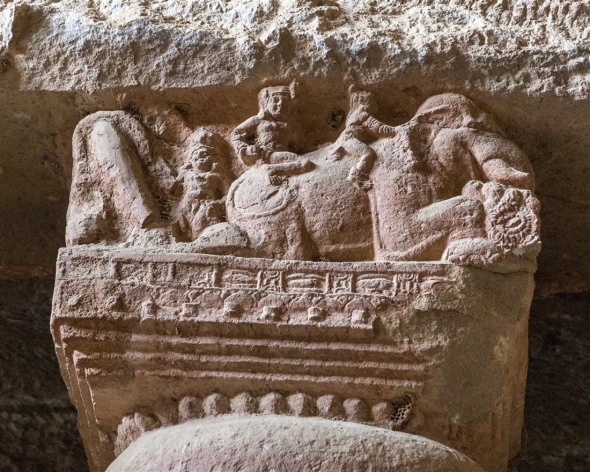




















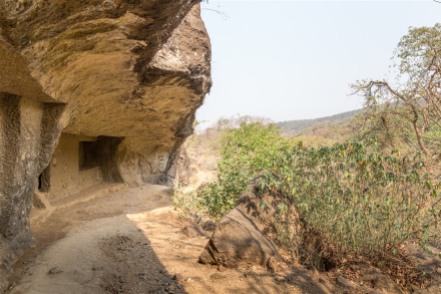

























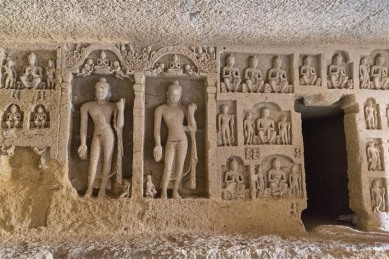
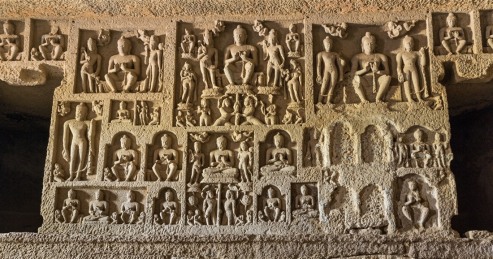











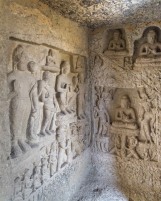





























Wow!
LikeLiked by 1 person
🙂
LikeLiked by 1 person
Great info. I live to read your blogs
LikeLiked by 1 person
THanks Rohit, that is very kind of you. Do stop by again soon ! 🙂
LikeLike
Kanheri caves is one of my favourite places in the city, partly due to the fact that I get to cycle to the caves from the Park gate 🙂
And yes, I agree that it’s difficult to cover the entire cave complex in one visit. I hvane’t even explored half of the complex despite going there a bunch of times!
LikeLiked by 1 person
I found it difficult to know how much of it I did see ! I envy you living so close to such a place, and cycling up to the caves in the park must be wonderful !
LikeLiked by 1 person
Hi Kevin. Do let me know if you want to see caves in Gujarat or even in Mumbai. Would like to join you. I am currently at the Maharaja Sayajirao University of Baroda, Vadodara.
LikeLiked by 1 person
Hi Ritvik. Have been to Baroda and around Ahmedabad, wasn’t aware of many caves in Gujarat – where are they ?
LikeLike
Loved the description and the photos.Amazing art work.very sad that though I am an Indian,still feel missing something not visiting these places.thank you
LikeLiked by 1 person
I never realized there were so many rock-cut caves in India besides the Kailasa temple in Ellora.
LikeLiked by 1 person
Thanks once again. I have spent time exploring Kanheri. I found photography a challenge – even with a good torch. Your photos are, as usual, superb. Thank you.
LikeLike
Thanks once again. I have spent time exploring Kanheri. I found photography a challenge – even with a good torch. Your photos are, as usual, superb. Thank you. Have you visited the caves at Aurangabad. Both cave sites are of real interest.
LikeLiked by 1 person
The caves around Aurangabad remain on my list Bill…hopefully next year !
LikeLike
Nice Photos. Did you used tripod?
LikeLiked by 1 person
I didn’t – they’re usually not allowed at these sites. So it’s down to high ISO and a low f-stop. If I can get the shutter speed up to around 1/40th of a second and take a few rapid consecutive shots, usually one will turn out o. A few times I rested my camera on the ground, the planet can sometimes be the best tripod although the angle isn’t great 🙂
LikeLiked by 1 person
Thanks
LikeLike
Excellent information.. Value addition to my Buddhist study. I shall be indebted to you.
LikeLiked by 1 person
Thanks for your kind comments Madan, I’m a little addicted to Buddhist rock-cut architecture 😀
LikeLike
Since I am the student of Ancient Indian history and cultural studies. We were to write report on this cave. There are many research paper out there ..but i needed proper images so that i can recall wht i saw…then i landed to your post. Thanks dude. Your work helped me.
LikeLiked by 1 person